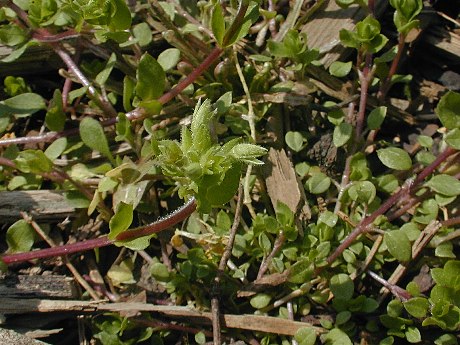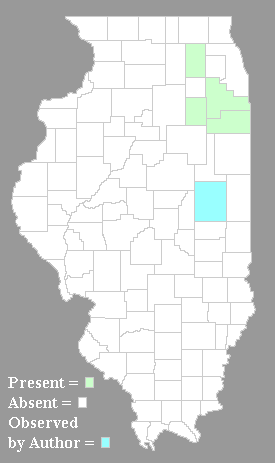Description: This plant is a winter or spring annual; it is prostrate or spreading, producing stems up to 20" long. There is very little branching of the stems, except at the base of the plant. The stems are light green to reddish purple and have conspicuous lines of white hair, although older stems become glabrous. Rather widely spaced along these stems are pairs of opposite leaves. Each leaf is ovate, glabrous, smooth along the margin, and up to 1/2" long and 1/3" (8 mm.) across. The older leaves near the base of the plant have ciliate petioles, while the younger leaves are sessile, but larger in size.

A small cluster of
about 3-6 flowers occurs at the end of each stem. This flower cluster
is subtended by leafy bracts. Each flower is about 1/8" (3 mm.) long,
consisting of 5 green sepals that are lanceolate, 3-10 stamens, 3
styles, and no petals. The pedicel of each flower is rather short and
pubescent. The blooming period occurs during the spring and lasts about
3 weeks. Each flower is replaced by an elongated seed capsule
containing numerous tiny seeds. The root system is shallow and fibrous.
This plant spreads by reseeding itself, and it can also spread
vegetatively by forming rootlets at the leaf nodes.
Cultivation:
The preference is full or partial sun, moist to mesic conditions, and
soil that is loamy or sandy. Growth occurs from early to mid-spring
when the weather is still cool. It forms mature seeds during late
spring and dies down by the summer. This plant appears to be quite
aggressive.
 Range & Habitat:
Apetalous Chickweed was first identified in Illinois in 1985, and it
has since established itself in several NE counties. It is also
well-established in Urbana, Illinois, of Champaign County, and seems
likely to spread to other areas of the state. Habitats include fields
(including sandy
fields), lawns, gardens, areas along sidewalks, and other disturbed
open areas that are reasonably moist during the spring. It is able to
survive in lawns because of its prostrate habit, and most vegetative
growth occurs prior to regular mowing of grass and application of
herbicides. This species is adventive from Eurasia.
Range & Habitat:
Apetalous Chickweed was first identified in Illinois in 1985, and it
has since established itself in several NE counties. It is also
well-established in Urbana, Illinois, of Champaign County, and seems
likely to spread to other areas of the state. Habitats include fields
(including sandy
fields), lawns, gardens, areas along sidewalks, and other disturbed
open areas that are reasonably moist during the spring. It is able to
survive in lawns because of its prostrate habit, and most vegetative
growth occurs prior to regular mowing of grass and application of
herbicides. This species is adventive from Eurasia.
Faunal Associations:
The insignificant flowers attract few pollinating insects. The foliage
of chickweeds is eaten by the caterpillars of several moths, including Agrostis
venerabilis (Venerable Dart), Lobocleta ossularia (Drab
Brown Wave), and Haematopis grataria (Chickweed
Geometer). Rabbits also eat the foliage of chickweeds during the spring
when little else is available.
Photographic Location:
A mulched flower bed at the webmaster's apartment in Urbana, Illinois.
Apetalous Chickweed is locally common in lawns along sidewalks and
roadsides, sometimes forming sizable colonies. One of the flowers in
the photograph is in full bloom, although it is difficult to see.
Comments:
This is the only chickweed in Illinois that produces green flowers
without petals, which makes identification easy. Apetalous Chickweed is
similar to Stellaria meadia (Common Chickweed) in
having ovate leaves, stems with lines of hairs, and a variable number
of stamens in each flower. The flowers of Common Chickweed have deeply
notched white petals, like many other chickweeds. It is not entirely
clear how the seeds of Apetalous Chickweed are being dispersed across
the state, although humans appear to have a major role. It is possible
that the seeds become stuck in the muddy tire treads of motor vehicles,
or they may cling to the bottom of shoes. The soil of horticultural
plants often contain the seeds of weeds that flourish in nurseries,
which may account for the appearance of Apetalous Chickweed and other
weedy plants in flower beds.